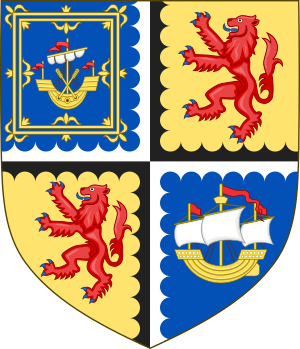John Sinclair, 3rd Earl of Caithness facts for kids
Quick facts for kids
John Sinclair
|
|
|---|---|
| Earl of Caithness | |

Earl of Caithness Coat of Arms
|
|
| Predecessor | William Sinclair, 2nd Earl of Caithness |
| Successor | George Sinclair, 4th Earl of Caithness |
| Died | 1529 |
| Noble family | Clan Sinclair |
| Father | William Sinclair, 2nd Earl of Caithness |
| Mother | Margaret Keith |
Meet John Sinclair, a powerful Scottish nobleman who lived a long time ago! He was the 3rd Earl of Caithness and the leader, or chief, of a famous group called Clan Sinclair. This clan was an important family from the Scottish Highlands. John Sinclair passed away in 1529.
Contents
John's Early Life
John Sinclair was the son of William Sinclair, 2nd Earl of Caithness. His mother was Margaret Keith, whose father was Sir Gilbert Keith of Inverugie.
Sadly, John's father died in a big battle called the Battle of Flodden in 1513. This meant John became the Earl of Caithness at a young age.
Becoming the Earl of Caithness
After his father's death, John officially became the Earl of Caithness on November 24, 1513. He received important documents, called charters, from the King.
One charter, dated July 14, 1527, gave him and his wife, Elizabeth Sutherland of Duffus, lands in Keiss, Stane, and Rowdale in Caithness. This document also said that his son, William Sinclair, would become the Earl after John.
On July 18, 1527, John received another charter for lands in Greeneland and Wester Clyth.
Working with Other Leaders
John Sinclair, the Earl of Caithness, often made agreements with other powerful leaders. For example, he and Adam Gordon, the Earl of Sutherland, agreed to be friends and support each other. They even exchanged some lands.
Later, the Earls of Caithness and Sutherland had a disagreement about land. They took their case to the Lords of Council and Session, who were like a high court. A bishop named Gavin Dunbar helped them settle their differences peacefully in 1524.
In 1528, King James V of Scotland wanted to deal with a "troublesome" group called the "Kin of Clanquhattane" (Clan Chattan). The Earl of Caithness was asked to help, but it seems nothing much happened with that plan.
The Orkney Expedition
In 1529, John Sinclair, the 3rd Earl of Caithness, was killed during a trip to Orkney.
The year before, there had been a rebellion in the Orkney Isles. Two brothers, James and Edward Sinclair, led this uprising against William, Lord Sinclair. The Earl of Caithness went to Orkney to help his relatives.
However, in a battle called the Battle of Summerdale on May 18, 1529, the Earl of Caithness and many of his men were defeated and killed. James Sinclair, who was the Governor of Orkney, led the forces that stopped the rebellion.
John's Family
John Sinclair married Elizabeth, who was the daughter of William Sutherland, 5th of Duffus. They had several children:
- William Sinclair, who was known as the Master of Caithness. He passed away in 1527 and did not have any children.
- George Sinclair, 4th Earl of Caithness, who became the next Earl after his father.
- Janet Sinclair, who married Alexander Ross of Balnagown.
- David Sinclair, who was John's son but born outside of marriage. He worked for the Bishop of Caithness. David is thought to be the ancestor of the noble Sinclair families of Dun and Forss.
See Also

